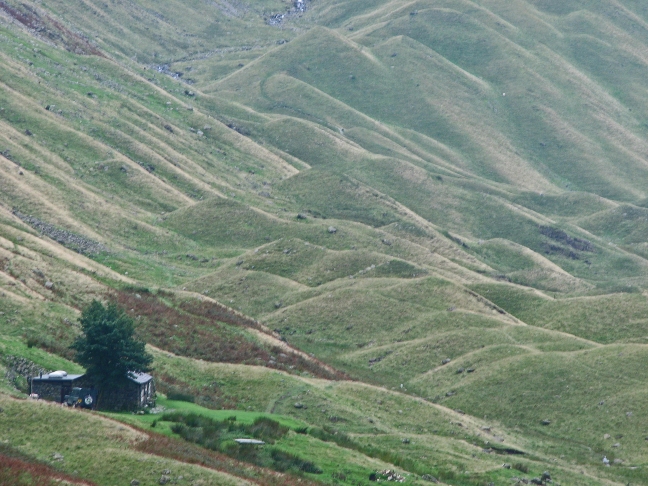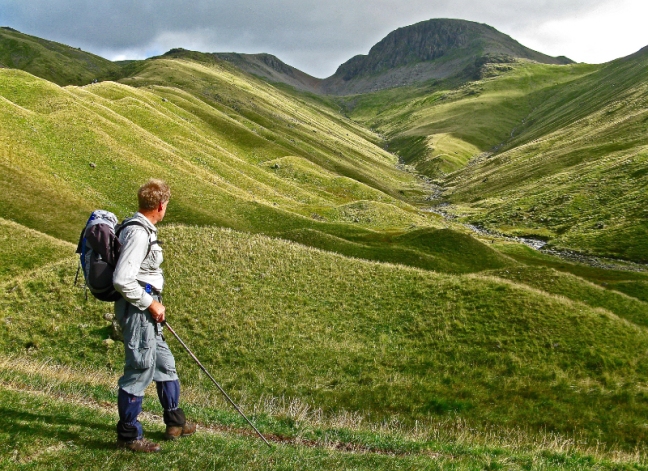Post 25. Ennerdale Youth Hostel was a basic hostel with no electricity, resulting in a cold shower and gas lamps for light (but now in 2015 is refurbished and much more luxurious with electricity etc). The nearest pub was back at Ennerdale Bridge some four miles away. However, some interesting characters, also walking coast to coast, improved the evening. It struck me as a little odd that a group of Americans had embarked on this walk in shorts, with no waterproofs. It had seemed to pass them by that they were in one of the wettest places in England and snow often fell at this time of year; it is one thing to be optimistic, but another to be suicidal.
Meanwhile, three young police constables had decided to stop walking the beat, instead walking coast to coast. They were carrying tents and other paraphernalia resulting in packs that weighed sixty-pounds, which inevitably gave them horrendous blisters and resulted in them being totally exhausted. I am sure they never had this problem on Dixon of Dock Green, Z Cars, or the Bill. The intrepid constables were wishing they were back dealing with criminals. They were doing the walk for charity and being a ‘Good Samaritan’, I let them have some of my Compeed blister kits, but nearly regretted this later on in the walk. They were never seen again on the walk and were last heard of trying to send underpants, truncheons, and other weighty items back to their home town of Nottingham.
30 March 1991: Day 2 – Ennerdale Youth Hostel to Longthwaite Youth Hostel (Borrowdale) – 17 miles as opposed to the normal 9 miles
At breakfast we met Theresa a teacher, who clearly felt she was giving a lesson on walking. Aged about forty-five, she and her husband had sold their car so that they could do more long-distance walking, a somewhat extreme measure even in my book. They then told us to keep our pack weight down by having flip-flops instead of trainers for the evening. I didn’t have chance to tell them that I took trainers for the road walking sections and that flip-flops were probably better suited to a beach, which I had left some 19 miles earlier. I distinctly got the impression that I should not talk in class.
‘Have you heard the weather forecast?’ she boomed, so that everyone in the hostel heard her.
‘No Miss,’ I tamely replied.
‘I phoned the Lake District weather line this morning and it is cloud up to five hundred feet.’ She bellowed.
‘Up to five hundred feet?’ I replied somewhat surprised, savouring prospects of high-level routes with cloud in the valley below.
‘Yes, isn’t that good,’ she said. ‘We are going to do the high level route over High Stile.’ Wainwright describes this as a delectable alternative route, only available in clear weather for only very strong and experienced fell-walkers. Seeing that her husband had a knee bandage and was older than us, we fancied our chances on the high-level route.
We left the hostel at 9.00am, excited at the prospect of stunning views from the top of the High Stile ridge with inverted cloud below us. It was still misty as we left the hostel but with much huffing and puffing we reached the summit of Red Pike at 2479 feet. Trouble was, we still couldn’t see a thing. Ever optimistic and knowing that, according to Theresa’s weather report, the cloud should soon disperse, we started to walk along the ridge. The mist got thicker and thicker until we came upon a chasm, which dropped relentlessly down to the void in front of us.
‘I’m not going down there,’ I said to Archie, who by this time had gone into a silent anxious mood. All I could see below me was swirling mist. ‘Lets go back down the way we came and follow the low-level route?’

Archie looked through his steamed up glasses for two seconds, with water dripping off his nose, then nodded in agreement. With great relief we arrived at the bottom, at which point we met a scout leader.
‘Oh yes, I heard that weather forecast, it was cloud down to five hundred feet,’ he said.
On hearing this profound but true statement, we decided to stop for an early lunch. Hopefully, we might see Theresa and be able to throw her in the River Liza.
Instead along came Bill and his mate. They carried hip-flasks of whisky and talked about nothing else apart from the pubs already entered on Coast to Coast and the location of the next ones to come. We persuaded them that perhaps the high-level route would not be their best option, but they were only convinced when we added there were no pubs at over 2,000 feet.

For the next 4 miles through Ennerdale forest we were told the pros and cons of every brew in the world, despite the fact that there was no pub for 8 miles. Now to be fair this was better than looking at the view through the woods, which was none existent. Britain was once covered almost entirely with woodland, but following the Industrial Revolution nearly every tree was chopped down. Big mistake. The next big mistake was in 1919 when it was decided to appoint the Forestry Commission to replace these trees with five million acres of fast-growing conifers. The problem for the Forestry Commission is that they couldn’t see the wood for the trees and therefore didn’t see what they were destroying or what they were creating. In Ennerdale; they planted conifers in regiments so close together that nearly all light and wildlife had been extinguished in what is one of England’s finest valleys. There was no oak, silver birch, ash, sycamore or other delightful broad trees. Some years later the Forestry Commission was replaced by the Forestry Enterprise, which has, to its credit, started planting mixed woods in Ennerdale and other parts of the country. Indeed Ennerdale is now a Wild Valley.

On arrival at the Black Sail Hut Youth Hostel, England’s remotest and best situated hostel, Bill pulled out his Wainwright guide book and read from it ‘ .. to Loft Beck, which ascend steeply by a path on the far bank.’

We all religiously followed the instructions crossing the beck, then, as we started to climb, I decided to do a runner to get away from pub talk. Dramatically increasing my pace, Archie followed suit as he didn’t want to be left behind in the swirling mist. The path climbed and climbed, then I heard some whistles penetrating the mist.
‘Do you think someone is lost?’ I said.
‘It’s probably Bill and his mate,’ Archie said, panting for breath as we went up and up.
‘It’s funny, but I don’t recognise that gully off left. It’s not shown on the map,’ I said puzzled. We suddenly arrived at a level junction of paths and some walkers were standing talking, trying to decide on their route.
‘Where are we?’ I said, admitting we were now totally lost.
‘You’re at the Black Sail Pass.’
‘We can’t be,’ I said astonished, ‘that’s completely the wrong direction to where we should be going.’ We had in fact crossed the River Liza and not crossed Loft Beck.

































